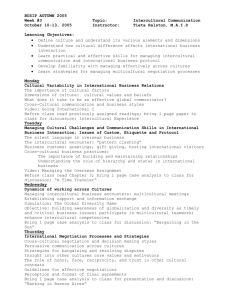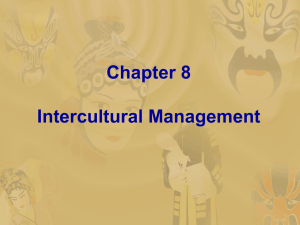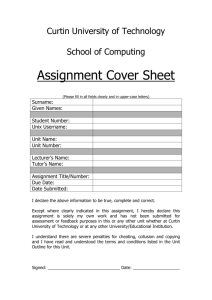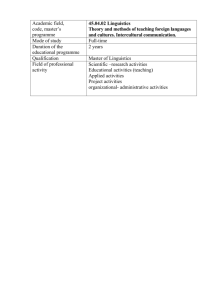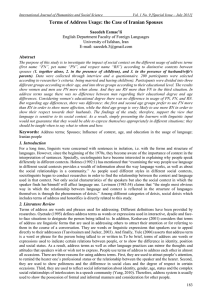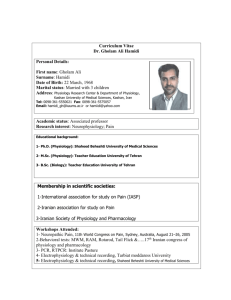curtin university of technology
advertisement
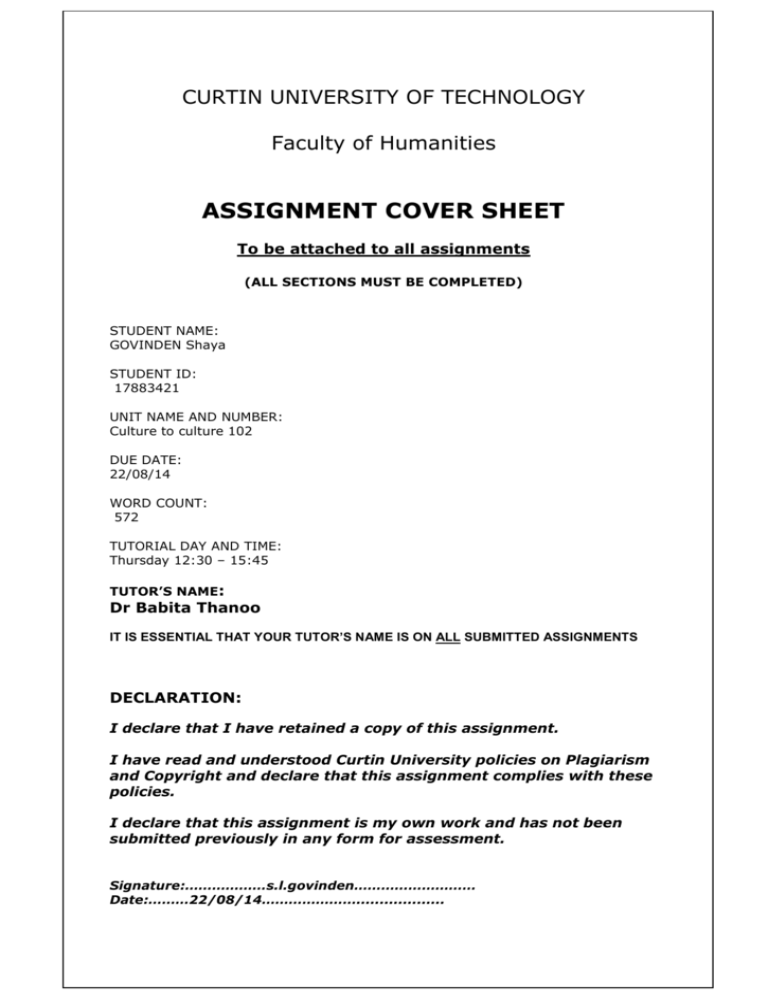
CURTIN UNIVERSITY OF TECHNOLOGY Faculty of Humanities ASSIGNMENT COVER SHEET To be attached to all assignments (ALL SECTIONS MUST BE COMPLETED) STUDENT NAME: GOVINDEN Shaya STUDENT ID: 17883421 UNIT NAME AND NUMBER: Culture to culture 102 DUE DATE: 22/08/14 WORD COUNT: 572 TUTORIAL DAY AND TIME: Thursday 12:30 – 15:45 TUTOR’S NAME: Dr Babita Thanoo IT IS ESSENTIAL THAT YOUR TUTOR’S NAME IS ON ALL SUBMITTED ASSIGNMENTS DECLARATION: I declare that I have retained a copy of this assignment. I have read and understood Curtin University policies on Plagiarism and Copyright and declare that this assignment complies with these policies. I declare that this assignment is my own work and has not been submitted previously in any form for assessment. Signature:………………s.l.govinden……………………… Date:………22/08/14…………………................... Cultural Identity can be defined as an identity or a feeling of forming part Of a self-conception and perception of an ethnicity, religion, social standard, nationality, generation, neighbourhood or any kind of generation that have its own culture. In this reflection I will discuss and analyse how the terms identity and “cultures within cultures” has an impact in our society, our culture and how does it influence our identity. The two texts are from the book “INTERCULTURAL COMMUNICATIONby Holiday, Hyde and Kullman pp7-11 and 92-96 which are about identity. In the first that I am reflecting, it deals with people thinking with an essentialist view on Parisa, an Iranian girl, who worked hard at changing the way her colleagues view her as an Iranian woman. What I appreciated more was the way she fought back her colleagues beliefs that they had on Iranians women that is being all subordinated. People have a stereotype thinking of Iranian people, even I shared the same view unit I read this article; that is Iranian women are conservative, they wear hijabs and that Iranians women were being ruled by the males. Parisa shows that she is independent, educated, and worldly and does work and is still an Iranian woman. Parisa wanted to illustrate a positive meaning of her religion and culture. She has a non-essentialist point of view, whereas her colleagues had a negative judgment. This text make me feels that even though we are living in a modern life we might believe that things goes in a convinced direction, but in reality, is not what we believe it is. It is a fact that cannot be denied that all of us are stereotype at some extent. The second text again about identity raise a question of “sub cultures” or “Cultures within cultures”, as in the text, the main character, Lopez believe that he would his life be better by Americanising himself. According to me for Lopez being or looking like a Peruvian is inferior to Americans. Lopez believes that if he doesn’t americanise himself he will live a low standard life. To show that he does not believe that American life style is superior to Peruvians, the author brings a second text in the first one, it is about cultures identity. In the text it clearly demonstrate that the American -Indians are considered as different being based on their culture, moreover in some way being deprived of their right of being equals to American; to me it resume to the fact that their identity is being taken away from them, as your rights are based on who you actually are. I believe that the author is trying to make us understand that the identity of one self does not come from how or where we were born but in fact that ourselves have created it and we accept we belong to it. The author said “unfortunately for him, from a rosy dream into a hellish nightmare” (Rybeyro, J.R(1972)). The author is trying to tell us that Lopez might regret what he did. Lopez was being influenced by his surroundings at that time. To conclude, from reading theses texts have understood how identity can be stereotyped and how sub culture might make anyone feel inferior to other’s culture despite not wanting to. I have also understood that theses two, that is identity and the sub culture are two things that work tighter. References List: Holliday Adrian, Martin Hyde and John Kullman –“INTERCULTURAL COMMUNICATIONS” pp. 7-11 Ribeyro, J.R. (1972) “Barbara” from la Palabra del Mundo, collected short stories, translated by D.Douglas (1986) from On Being Foreign: Culture Shock in Short FictionAn International Anthology, Lewis T.J and Jungman, R.E (eds), Yarmouth, Maine: intercultural Press, from the book – “INTERCULTURAL COMMUNICATION pp. 9296”

